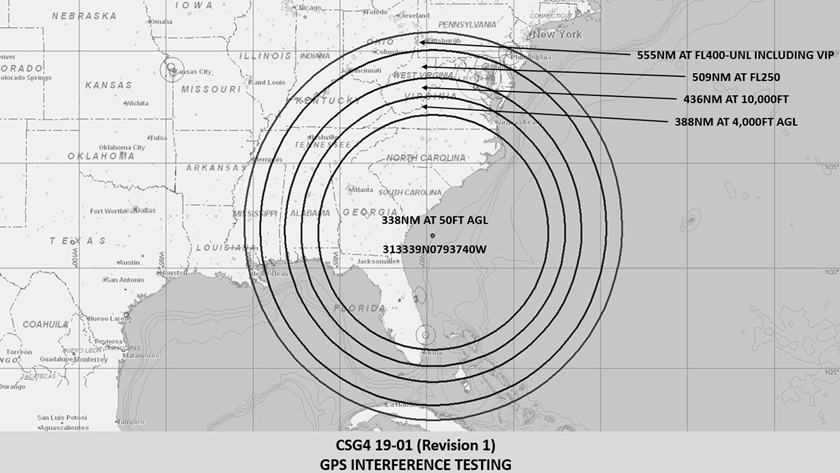GPS, ADS-B may be out in Southeast during 'interference tests'
AOPA calls FAA’s response to flight safety risk unacceptable
GPS air navigation may be unreliable or unavailable in a vast swath of airspace in the eastern U.S. and the Caribbean during a military exercise involving GPS jamming between Feb. 6 and 10.
GPS-based services including Automatic Dependent Surveillance-Broadcast (ADS-B), the Ground Based Augmentation System, and the Wide Area Augmentation System could also be lost in a radius extending several hundred miles from the offshore operation’s center, the FAA said.
The FAA posted a flight advisory that gives the schedule of the tests that could degrade GPS from the Caribbean and Florida north to Pennsylvania, and as far west as eastern Louisiana, while a strike force is conducting a training operation off the Georgia coast. Notices to airmen have been issued for airspace in eight of the FAA’s Air Route Traffic Control Centers.
AOPA estimates that more than 2,000 airports—home bases to more than 28,600 aircraft—are located within the area’s lowest airspace contour.
Advocating for safety
AOPA has been working on multiple fronts to place greater focus on the safety of civil aviation during the proliferation of GPS-interference testing events. The tests, mostly staged in western states, have resulted in a growing number of pilot complaints—a problem expected to magnify as more general aviation pilots transition to GPS-based navigation. The number of jamming events and their locations are increasing.
The issue has struggled for traction with the FAA. A safety panel held in September 2018 ended with the FAA deadlocked on a path forward. In November 2018, AOPA reported on instances of aircraft losing GPS navigation signals during testing—and in several cases, veering off course. Instances have been documented in which air traffic control temporarily lost the tracks of ADS-B Out-equipped aircraft.
In a vivid example of direct hazard to aircraft control in April 2016, an Embraer Phenom 300 business jet entered a Dutch roll and an emergency descent after its yaw damper disengaged; the aircraft’s dual attitude and heading reference systems had reacted differently to the GPS signal outage. This issue was subsequently corrected for this aircraft.
AOPA is aware of hundreds of reports of interference to aircraft during events for which notams were issued, and the FAA has collected many more in the last year. In one example that came to AOPA’s attention, an aircraft lost navigation capability and did not regain it until after landing. During a GPS-interference event in Alaska, an aircraft departed an airport under IFR and lost GPS on the initial climb. Other reports have highlighted aircraft veering off course and heading toward active military airspace. The wide range of reports makes clear that interference affects aircraft differently, and recovery may not occur immediately after the aircraft exits the jammed area.
Pilot concern is mounting. In a January 2019 AOPA survey, more than 64 percent of 1,239 pilots who responded noted concern about the impact of interference on their use of GPS and ADS-B. (In some cases, pilots who reported experiencing signal degradation said ATC had been unaware the jamming was occurring.)
Meanwhile, the aviation community awaits the FAA’s response to 25 recommendations presented in March 2018 by an RTCA working group, co-chaired by AOPA, and approved by the RTCA tactical operations committee. The recommendations range from improving the preflight resources available to pilots to clarifying FAA guidance on reporting GPS anomalies.
“AOPA is very concerned that government officials have not addressed the known safety issues,” Duke said. “The interference events are important to the military and our national defense, and the FAA must assure that flight safety is not compromised. We have worked collaboratively with industry, the FAA, and the Department of Defense to find solutions, but we have yet to see action.”
‘Stop buzzer’
Pilots who encounter hazardous interruption of GPS navigation or who have flight-control issues should be aware that they can say the phrase “Stop buzzer” to air traffic control, which initiates the process of interrupting the testing to restore navigation signal reception, Duke said.
During previous GPS-interference events, pilots declared emergencies, but the jamming continued because ATC did not understand that the emergency was related to the GPS interference. According to the Pilot/Controller Glossary, “stop buzzer” is a term used by ATC to request suspension of “electronic attack activity.” Pilots should only use the phrase when communicating with ATC, or over the emergency frequency 121.5 MHz, if a safety-of-flight issue is encountered during a known GPS interference event. Using this unique phrase when experiencing an unsafe condition related to GPS interference will ensure that ATC and the military react appropriately by stopping the jamming, Duke said.
“Pilots should only say ‘stop buzzer’ when something unsafe is occurring that warrants declaring an emergency. They should make sure ATC knows that the emergency is GPS-related and that halting the GPS interference will resolve the emergency,” he said.
The FAA encouraged pilots to report GPS anomalies in accordance with Aeronautical Information Manual paragraphs 1-1-13 and 5-3-3. AOPA encourages pilots to document any effects of GPS-interference testing on their aircraft by filing a report using the FAA's GPS Anomaly Reporting Form.





